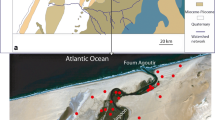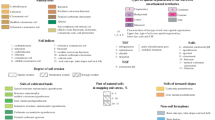Abstract
Active development of the Cis-Ol’khon area in the past decades enhanced the conflicts between land users related to multifunctional land use (residential, agricultural, recreational, and nature-protective), which should be resolved on the basis of scientific data. The aim of this study is to compile a soil map of the coastal zone of the Ol’khon Plateau of 26.3 km2 in area. This area is subjected to increasing recreational impact against the background of grazing and residential land use. Small-scale soil maps of this area show only the most general regularities of the geographical distribution of soils and do not reflect specific features of the soil cover. A digital soil map (on a scale of 1 : 25 000) of the area around the Kurkut Bay was compiled on the basis of the landscape-typological map by M.V. Zagorskaya and a network of 71 soil pits examined in 2015–2018). The classification of Russian soils of 2004 was used for the legend of the soil map; it was also correlated with the World Reference Base for Soil Resources (WRB-2014) system and the Classification and Diagnostics of Soils of the Soviet Union (1977), which was used in the soil map of the Elantsy state farm. Soil subtypes reflecting the entire range of soils in the studied area are the main taxonomic units in the legend for the soil map. Small and frequently alternating elementary soil areas in the studied region are formed under the impact of contrasting soil-forming factors. Lithozems (Leptosols) and gray-humus soils (Dystric Leptosols) occupy the main area. The analytical data and the soil map may be used as the basis for soil monitoring.


Similar content being viewed by others
REFERENCES
B. P. Agafonov, Exolithodynamics of the Baikal Rift Zone (Nauka, Novosibirsk, 1990) [in Russian].
Atlas of Lake Baikal, Ed. by G. I. Galazii (Federal Service of Geodesy and Cartography of Russia, Moscow, 1993) [in Russian].
Irkutsk Oblast: Ecological Conditions for Development. Atlas (Moscow, 2004) [in Russian].
Atlas of Irkutsk Oblast (General Office of Geodesy and Cartography, Moscow, 1962) [in Russian].
Functions of coastal geosystems of Cis-Baikal zone and their formation factors, Initial data, Database, 2017. https://doi.org/10.13140/RG.2.2.32634.18883
A. F. Vadyunina and Z. A. Korchagina, Field and Laboratory Methods to Study Physical Properties of Soils and Grounds (Vysshaya Shkola, Moscow, 1961) [in Russian].
L. A. Vorob’eva, Chemical Analysis of Soils (Moscow State Univ., Moscow, 1998) [in Russian].
G. A. Vorob’eva, Soil as a Chronicle of Natural Events in the Cis-Baikal Region: Evolution and Classification of Soils (Irkutsk State Univ., Irkutsk, 2010) [in Russian].
K. P. Kalinina and A. S. Kul’chitskii, State Geological Map of the Russian Federation, Scale 1 : 1 000 000, Series Angara-Yenisei, Sheet N-48. Irkutsk: Explanatory Note (Nedra, Moscow, 1964) [in Russian].
State Soil Map of the Soviet Union, Scale 1 : 1 000 000, Sheet N-48. Irkutsk (Dokuchaev Soil Science Inst., Academy of Sciences of USSR, Moscow, 1977) [in Russian].
L. V. Dan’ko, A. P. Sizykh, and S. B. Kuz’min, “Spatial structure of geosystems of Priol’khonie by the example of a model polygon-transect,” in The Structure, Functions, and Evolution of Mountain Landscapes of Western Cis-Baikal Region (Institute of Geography, Siberian Branch, Russian Academy of Sciences, Irkutsk, 2005), pp. 11–19.
M. V. Zagorskaya, “Landscape structure of Central Priol’khonie,” Geogr. Prirod. Resur., No. 4, 58–68 (2004).
T. I. Znamenskaya, Yu. V. Vanteeva, and S. V. Solodyankina, “Factors of the development of water erosion in the zone of recreation activity in the Ol’khon region,” Eurasian Soil Sci. 2, 221–228 (2018).
V. A. Karavaev, M. Yu. Opekunova, S. V. Solodyankina, T. I. Znamenskaya, and Yu. V. Vanteeva, “Impact of recreation exploration on linear erosion in Priol’khon’e,” Geomorfologiya, No. 1, 93–104 (2019). https://doi.org/10.31857/S0435-42812019193-106
N. A. Kachinskii, Mechanical and Microaggregate Analyses of Soils (Moscow State Univ., Moscow, 1958) [in Russian]
Classification and Diagnostics of Soils of the Soviet Union (Kolos, Moscow, 1977) [in Russian].
L. L. Shishov, V. D. Tonkonogov, I. I. Lebedeva, and M. I. Gerasimova, Classification and Diagnostic System of Russian Soils (Oikumena, Smolensk, 2004) [in Russian].
G. F. Koposov, Genesis of Mountainous Soils in the Cis-Baikal Region (Nauka, Novosibirsk, 1983) [in Russian].
V. A. Kuz’min, Geochemistry of Soils of the South of Eastern Siberia (Sochava Institute of Geography, Siberian Branch, Russian Academy of Sciences, Irkutsk, 2005) [in Russian].
V. A. Kuz’min and V. A. Snytko, “Geochemical differences of soils of contrasting landscapes within the Cis-Baikal National Park,” in Geography of Soils and Geochemistry of Landscapes of Siberia (Institute of Geography, Siberian Branch, Russian Academy of Sciences, Irkutsk, 1988), pp. 41–55.
S. B. Kuz’min, “Geomorphology of Primorskii Fracture Zone (Western Cis-Baikal region),” Geomorfologiya, No. 4, 53–61 (1995).
S. B. Kuz’min and L. V. Dan’ko, Paleoecological Models of Ethnonatural Interactions (Geo, Novosibirsk, 2011) [in Russian].
V. P. Martynov, Soils of Cis-Baikal Mountains (Buryat. Knizhn. Izd., Ulan-Ude, 1965) [in Russian].
I. V. Nikolaev, Soils of Irkutsk Oblast (Vost.-Sib. Knizhn. Izd., Irkutsk, 1949) [in Russian].
M. Yu. Opekunova and S. A. Makarov, “Assessment of dangerous geological processes during recreation-tourist activities in Cis-Baikal region (Irkutsk oblast),” Sovrem. Probl. Servisa Turizma 12 (3), 121–132 (2018). https://doi.org/10.24411/1995-0411-2018-10311
Soil Map of Irkutsk Oblast, Scale 1 : 1 500 000, Ed. by V. T. Kolesnichenko and K. A. Ufimtseva (General Directorate of Geodesy and Cartography of USSR, Moscow, 1988) [in Russian].
Soil Map of the RSFSR, Scale 1 : 2 500 000, Ed. by V. M. Fridland (General Directorate of Geodesy and Cartography of USSR, Moscow, 1988) [in Russian].
Soil Map of Elantsy State Farm, Ol’khon District, Irkutsk Oblast, Scale: 1 : 25 000 (Ministry of Agriculture of the RSFSR, Moscow, 1977) [in Russian].
L. N. Semenova, E. G. Nechaeva, N. D. Davydova, A. I. Shchetnikov, et al., Interphase Landscape-Geochemical Heterogeneity. Trends in Landscape-Geochemical Processes in Geosystems of Southern Siberia (Nauka, Novosibirsk, 2004) [in Russian].
V. A. Snytko, Yu. M. Semenov, L. N. Semenova, and L. V. Dan’ko, “Geochemistry of landscapes in the basin of Lake Baikal,” Geogr. Prirod. Resur., No. 3, 191–197 (2007).
S. V. Solodyankina and Yu. V. Vanteeva, “Variability of plant productivity of coastal geosystems of Cis-Baikal region,” Geogr. Prirod. Resur., No. 2, 73–80 (2017). https://doi.org/10.21782/GiPR0206-1619-2017-2(73-80)
I. E. Trodimova, “Typification and cartography of climates of Baikal Mountain-Depression system,” Geogr. Prirod. Resur., No. 2, 53–61 (2002).
V. M. Fridland, “General statements of soil cartography,” in Problems of Geography, Genesis, and Classification of Soils (Nauka, Moscow, 1986), pp. 119–137.
Ts. Kh. Tsybzhitov, Ts. Ts. Tsybikdorzhiev, and A. Ts. Tsybzhitov, Soils of the Baikal Lake Basin, Vol. 1: Genesis, Geography, and Classification of Chestnut Soils (Nauka, Novosibirsk, 1999) [in Russian].
IUSS Working Group WRB, World Reference Base for Soil Resources2014, International Soil Classification System for Naming and Creating Legends for Soil Maps, Word Soil Resources Reports No. 106 (UN Food and Agriculture Organization, Rome, 201).
J. V. Vanteeva and S. V. Solodyankina, “Ecosystem functions of steppe landscapes near Lake Baikal,” Hasquetia 14 (1), 65–78 (2015). https://doi.org/10.1515/hacq-2015-0016
Funding
This study was performed within the framework of state assignment (registration nos. AAAA-A17-117041910169-4, AAAA-A17-117041910167-0AA) and was partially supported by the Russian Foundation for Basic Research (project no. 17-05-00588) and the Russian Geographical Society (project no. 17-05-41020 RGO–RFFI).
Author information
Authors and Affiliations
Corresponding author
Ethics declarations
The authors declare that they have no conflict of interest.
Additional information
Translated by I. Bel’chenko
Rights and permissions
About this article
Cite this article
Znamenskaya, T.I., Solodyankina, S.V. & Vanteeva, Y.V. Soil Cover of the Cis-Ol’khon Area, Baikal Region. Eurasian Soil Sc. 53, 707–714 (2020). https://doi.org/10.1134/S1064229320060162
Received:
Revised:
Accepted:
Published:
Issue Date:
DOI: https://doi.org/10.1134/S1064229320060162




